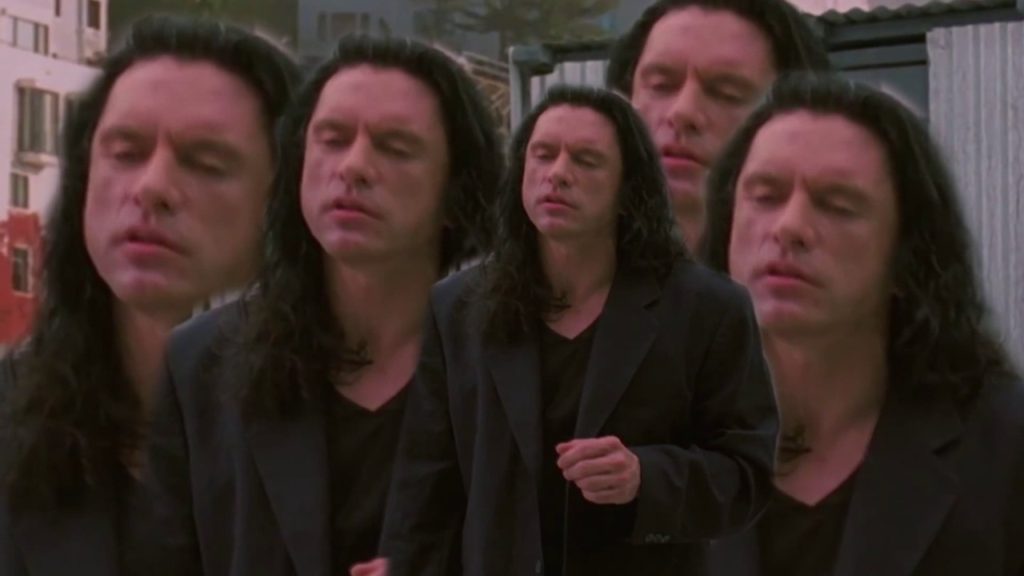Say what you will about The Room, but don’t disregard that 14 years later, you’re still saying it.
Tommy Wiseau’s 2003 unintentional comedy is lauded as the “Citizen Kane of bad movies,” yet now in theaters, the James Franco/Seth Rogan squad can be seen portraying Wiseau and the rest of the film’s original cast. Adapted from Room actor Greg Sestero’s book of the same name, The Disaster Artist gives us a behind the scenes tell-all of how Sestero met the mysterious Wiseau and how The Room came to be. But if the movie is truly as bad as the internet laments, why are plastic spoons still being thrown in theaters worldwide? Why is there a book and a movie created about this stinker? Most importantly, why the hell are we still talking about it?
As depicted in Franco’s film, Sestero and Wiseau met in an acting class in San Francisco in 1988. While Wiseau was far from pro, Sestero was drawn to the man’s fearlessness on stage after witnessing a run-through of a scene from A Streetcar Named Desire. The two forged a solid, yet strange friendship, traveling to James Dean’s death site, performing scenes in the middle of crowded diners, and moving to Wiseau’s LA apartment together after only a couple months.
The questions start piling up: Where is Wiseau from? (He won’t say.) How old is he? (He pretends he’s in his 20’s.) How does he get the money for his nice car and second apartment he barely uses? (Don’t ask me.) As the two attempt to jumpstart their acting careers, Sestero lands an agent, but Tommy experiences failure again and again. He decides to take fate into his own hands: He writes his own screenplay called, The Room, which he plans to direct, star in, and produce. Sure.
I’m not sure I can begin to explain the phenomenon of The Room without abusing the word count here. It’s an experience. It baffles and consumes you. Your mind reels in perpetual disbelief. Wiseau self-produced the movie and spent $6 million on it after purchasing all of the equipment (unheard of in Hollywood), and filming in both 35mm and HD side by side (Seriously. Don’t ask.) To say this was an unconventional and borderline abusive set is playing nice. As shown in the new movie, Wiseau insisted on walking around set naked before a love scene. He was contentious with crew members and unjustly fired some of them at will. He built a set of an alleyway, despite having a real alleyway outside. The story unfolds like a true Hollywood nightmare.
Franco’s performance perfectly encapsulates the enigma that is Wiseau, from his undetectable accent and broken English, to his beast-like physicality. While Franco’s portrayal of Wiseau’s oddities is aces, he nails Wiseau’s humanity even more so. Franco described Wiseau as, “like Norma Desmond in Sunset Boulevard—someone who thinks that the movies will save them, who is very out of touch with who he is, and whose onscreen and off-screen life meld into each other.” When producers and acting coaches told him, “No, not in a million years,” he told himself, “Yes.” In the face of failure, Wiseau kept reaching for the Hollywood stars. His megalomania, ego, and abrasive personality are impossible to ignore, but Wiseau had heart and strove to be excellent at his craft. He never gave up the dream.
Though I read the book twice, by the end of the movie, I felt sort of inspired. (I repeat, I FELT INSPIRED BY TOMMY WISEAU.) When we break down all the on-set madness, mysterious money, bad acting, terrible dialogue, even worse script—and there’s a lot to unpack there— we’re left with a man who had an undying passion and was relentless in following it. A man who wanted to be somebody and do something, a really difficult something, and paved his own path. As strange as it may be, there’s beauty in that.
People love The Room for a lot of reasons—the spoon throwing, the terrible quotes, the technical flaws, the cancer-ridden B-stories that pop up only to never be talked about again, Denny and his lack of “fucking money”—Lord knows this is a movie that never stops giving. But there’s also a sincerity to it that is undeniable, heartbreaking even.
The Disaster Artist ends at the LA premiere of The Room, and as the audience begins to laugh at the movie in Wiseau’s presence, he oozes sadness. We see the life drain out of him. It’s hard to imagine what that must’ve been like for him in real life. But this man doesn’t know failure. He turned it around and accepted the reaction of his audience. He embraced his very serious (lol), very powerful (LOL) film as the black comedy he never intended it to be (though he denies this repeatedly). Wiseau may be a lot of things—an anomaly, a weirdo even…an auteur?—but he’s made a career out of making the best of it. He has kept the dream alive. That is the mad genius of Tommy Wiseau and The Room.




I still need to see this!